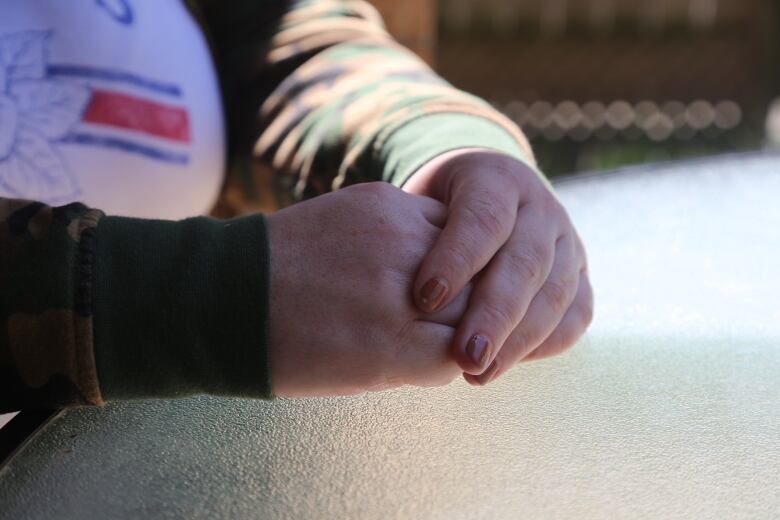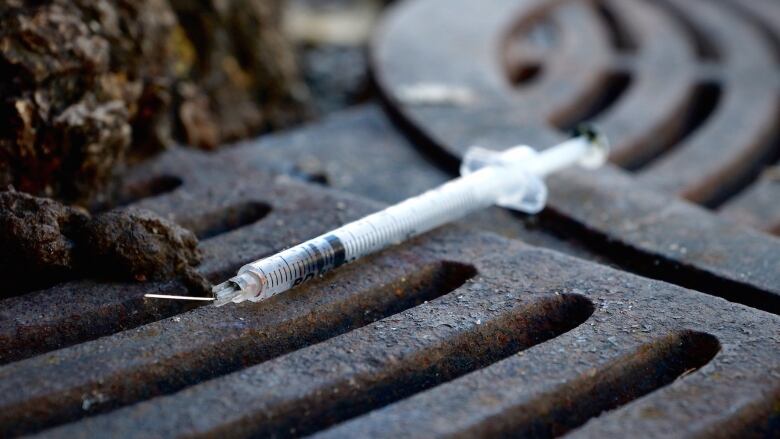Drugs make her a 'monster:' A Hamilton family's cry for help fighting addiction
'[Overdosing]doesn't really scare me anymore because I haven't died.'

Her daughter is lyingon the floorwith no signs of life. Her eyes are rolled back in her head. No matter what the woman does, shewon't wake up.
The womancan't count how many times she's found her daughter this way in the throes of an addiction that too often comes to this.
It turns her laughing, joking child into a monster whohurls abuse and puts herself in peril by neglectingher medical conditions.
But worse than the screaming, swearing andname-calling are these moments of quiet when the shouting stops and is replacedby astillness so close to death.
It's a scene that's led their little family tothe edgeso often, her daughter has told her she'sno longer afraid of overdosing.
"I feel like a failure," the womanalmost whispers. "No matter how much I try to help her. I try, I try so hard. Everybody keeps telling me I have to give up on her and let her go her own way, but I can't because I know what that's going to be."
The woman'sinitials are A.Y.CBC News has agreed to share her story and that of her daughterT.Y.using only the first letters of their names to protect them and the fragile hope they hold for their future.
It's a story of struggle with crystal meth and fentanyl addiction, coupled witha seemingly endless cycle of incarceration and overdoses that causes both mother and daughter to suffer.
Itshows how the battleagainst substance abuse is fought not just by the person with the addiction, but also also by family and loved ones, doing their best with few tools to counter the power of drugs. Every day it pushes their loveto the limit and lurking behind every fight is the fear that death is the only way it will end.

Perhaps most frighteningly of all, that's an eventuality that no longer seems to faze T.Y.
"[Overdosing]doesn't really scare me anymore because I haven't died," she says matter-of-factly during a recent phone call fromthe Hamilton-Wentworth Detention Centre, where she was locked up at the time for stealing a U-Haul truck with her boyfriend.
Despite her brushes with death, or maybe because of them, her sense of fear has been blunted. Still, there is one thing that does get through to her.
"The last couple of times that happened, seeing the fear in my mom's eyes scared me."
'I almost die ... quite often'
The first signs of trouble started when T.Y. was just three or four years old. Getting dressed for school would end in screaming matches and her heading off to class still wearing her pyjamas.
When the girlturned 11, her mother caught her smoking marijuana. Next cameprescription pills and eventually self-harm and heavier drugs.
Around that time they learned T.Y. also has Type 1 diabetes,a disease that requires insulin daily. With her addiction those shots getforgotten and shesometimes goes a week without a dose, even though that can cause someone to slip into a coma or worse.
I know she's a good person...but when she's on drugs she's just a monster.- A.Y.
"I almost die from it quite often," T.Y.explains.
"I wake up and I'm in the ICU. I don't remember how I got there, what happened, my mom is freaking out telling me I was saying weird things or I was almost dead. I have IVs in my neck. It's not good."
Along with the diabetes is a host of mental health concerns.
Doctors first told A.Y. her daughter had ADHD, but over the years that diagnosis ballooned to include a borderline personality disorder, anxiety and OCD.
Recent medical reports reviewed by CBC News detail herlitany of health-related afflictions, with one doctor bluntly stating if she doesn't get help she won't survive.
'I know she's a good person'
The two moved to Hamilton from the Maritimes about five years ago. A.Y. says if she had any idea what that change would bring, she'd never have come to the city.
Hamilton, like much of Canada, iscaught up in an opioidcrisis. Paramedicshave responded to 413 suspected opioid overdoses so far in 2019, with the number of 911 calls about overdoses hitting thehighest levels on record earlier this year.
Eighty-eightHamiltonians died from opioid overdoses in in 2017 a death rate 72 per cent higher than the rest of the province.Preliminary data for2018 shows there 103 such deaths, with another 19 probable deaths still being probed by the coroner.

Soon after they settled in the city, T.Y. headed out onto the street. At one point, her mother says, she tried to become a prostitute to pay for drugs. That's when the overdoses and time behind bars started stacking up.
"Right now I can't really tell you any good things about her because a lot of negatives have been going on," says A.Y., fighting back tears.
"I know she's a good person because I see it. She loves kids, she loves people, but when she's on drugs she's just a monster."
The woman feels anger, yes. But also guilt, fear and love.
"Believe" reads a sign hanging at the end of a beige hallway dotted with family portraits showing a smiling T.Y. as a child. The photos are surrounded byfresh plaster and even fresher holes, smashed infrustration and desperation.

Behind a closed door with a handkerchief for a handle is her daughter's room.
"The heart that loves is always young" reads looping letters stuck to the wall above the bed.
Below those words is chaos. Piles of dirty clothes commingle with fast-food cups, prescription bags and a moldy bong.
The mess all but completely hides the bed and floor. An open closet door gives a glimpse of even more clutter. An empty rack of clothes hangers showswhere everything that's currently covering the roombelongs.
She's going to end up dead.- A.Y.
T.Y. wasback home for a bit and living in that room. But she's banned from the property. She causes too much damage, too much trouble, so she moved out. She's going to try living on her own.
Her mom is worried. She's exhausted from racking her brain for a way to help her child.
Just a few weeks out ofjail, A.Y. says her daughter is already getting high again. She fears the cycle of overdoses, emergency room visitsand police knocking at the door is bound to start all over but she doesn't know what elseto do and it's taking a toll on her too.
"[T.Y.] is just trying to make herself feel good. She can't feel good naturally on her own, so she turns to drugs," A.Y. explains.
"I feel like I owe it to my daughter to help her, but my life is going too low, and it's making me at times feel depressed and withdrawn."

On the phone from jail, T.Y. soundedfriendly and animated despite her circumstances. As the voices of other inmates echoed in the background, she admittedshe breaks the law to feed her drug habit.
Stealing is the first crime she can remember committing, though it was a long time ago and she can't recall exactly what she took.
But breaking the law introduced her tosomething else too. In its own way, the rush of running from police created a craving of its own.
"I guess I liked it because of the adrenaline too," she explains."It's kind of addicting that way."
'Somebody'shurting ... help them'
Similarities between the two women are inescapable. Both are honest to the point of being blunt and share a sense of humour that allows them to laugh and joke even as their situation makes them cry and their voices crack with emotion.
Despite all that she'ssurvived,T.Y. is only 22.
She knows it's not too late for a life without addiction.
For a long time, T.Y. says methamphetamine and fentanyl have been her way of coping with the dark emotions that kill any desire she has to go outside andmake her worryabout other people and what they might think or say.
They've kept her somewhat stable for years, but she knows the drugs don't offer a real solution that will bring her to the future she wants.
I just need more hope."-T.Y.
Still, taking on those challenges without the substances she's relied on for years can be scary.
"I think it would be way easier to stop the drugs if I was happy. I'm not happy with my life. I just need my depression and mental health all dealt with," she says.
"I don't even know what I'm feeling most times. I feel like I have three emotions happy, mad and sad, or over-happy, over-mad and over-sad and that's it."
When stories about drug useorcrimes carried out to feed an addiction are shared on social media, A.Y. says she sees people's comments insulting "druggies" or"crack heads."They make her embarrassed. They also make her angry.
"Who caresaboutwho's to blame? The point is somebody'shurting, they need help. Help them," she says. "She's going to end up dead."
'No wait is acceptable'
The family has tried time and again to get T.Y. some mental health help, but say they windup waiting weeks for doctor's referrals that only lead to appointments scheduledmonths later, long after the moment when she mustered the willpower to fight. The risk of T.Y. using drugsgrows with every day that passes.

Dr.PaulKurdyak, a psychiatrist at theCentre for Addiction and Mental Health,has studiedwait time datain Canada, though he notes the mental health and addictions sector across the country has been slow to start keeping statistics on how long people are waiting for support.
Based on the information he has been able to review, Kurdyak said getting access to a psychiatrist for mental health reasons is more challenging than accessing other areas ofhealthcare. On top of that, within the mental health sector, people with an addiction have aneven harder timefindingpsychiatric support.

It's acombination that can keep people from care.
"If someone even seems remotely motivated, you kind of want to get them right then and there.Making them wait sets them up for failure," Kurdyak explains. "Because of the dire consequences I think no wait is acceptable."
Time behind bars represents brief periods of relief for the family. But A.Y. says her daughter'sdaysinside arewasted staring at a cell wall instead of being given skills to battleher addiction or taught what to do when she gets out.
T.Y. recognizes the cycle too, but says she feels helpless to change it.
"I come in jail and I start saying I want to quit drugs and I get out and I try but then I get back with my friends who do drugs and then it's like I'm addicted all over again and I don't want to get the help."
'I can change'
For a time last year she had resigned herself to being a meth-addict for the rest of her life.
She liked using meth, liked how it made her feel and had decided that's where her future lay.

But sheknows what happens to those who can't shake their reliance on substances. Some of the people she's friends with from the street or she sees coming in and out of jail are in their 30s, 40s or older.
"I see them going crazy. I see them never coming back from going crazy. These old people who are still on it, I don't want to be like that," she says.
"I'm still really young so I can still make a future for myself.I don't have to be like this for the rest of my life. It's not written in stone. I can change it. I just need more hope."












_(720p).jpg)


 OFFICIAL HD MUSIC VIDEO.jpg)
.jpg)



























































































